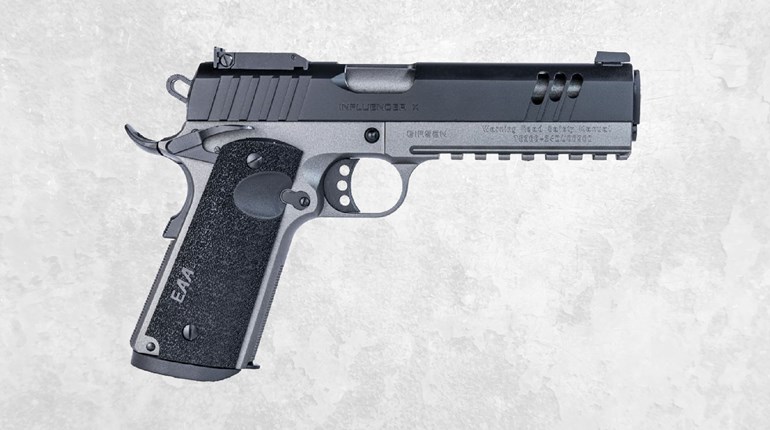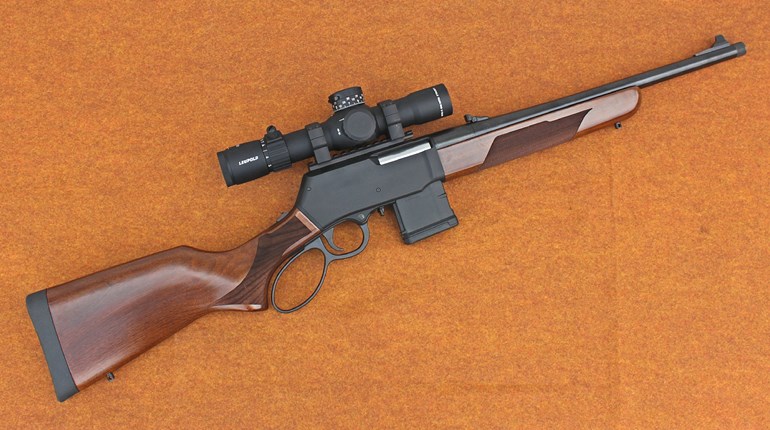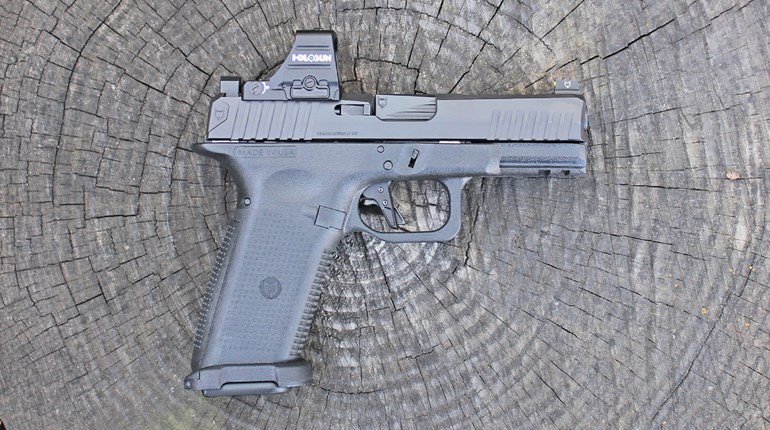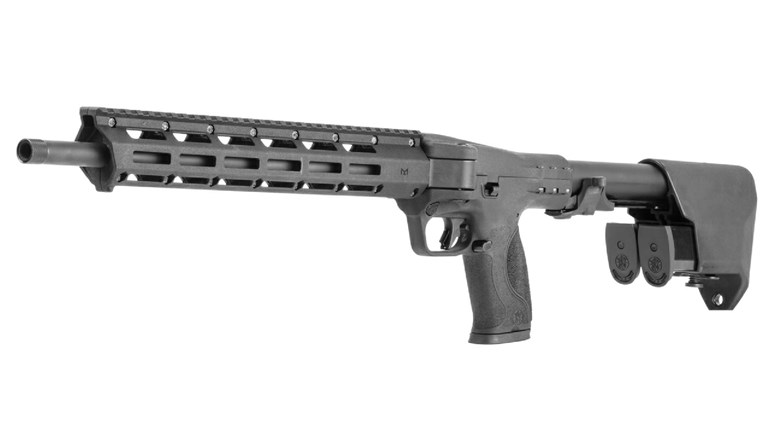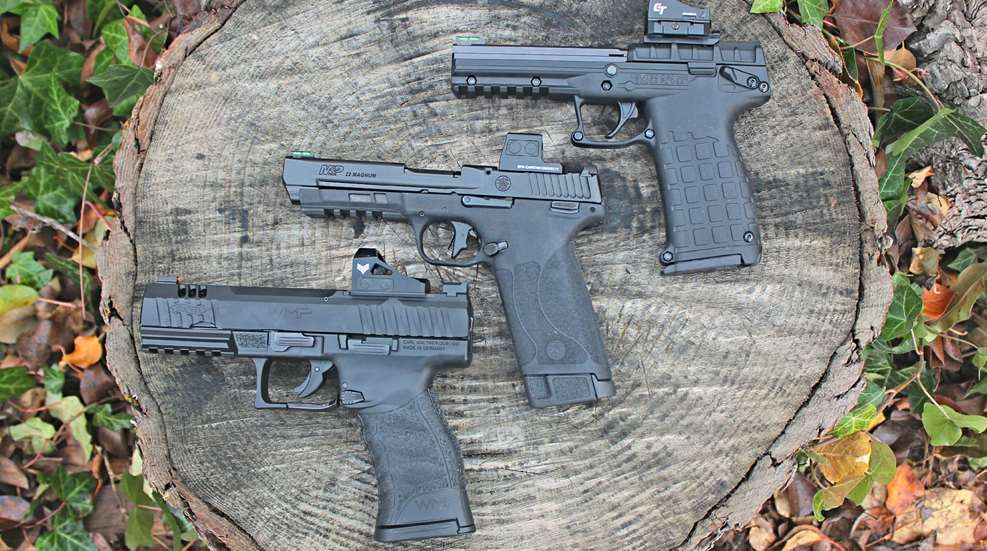
Over the last few years we’ve discussed the use of .22 LR handguns, pistols and revolvers, .22 LR rifles and .22 Mag. (.22 WMR) revolvers for use as low-recoil defensive options. But folks looking over this list will notice the absence of any conversation regarding semi-automatic .22 Mag. pistols. Before now there were simply not enough pistol models to choose from to warrant the conversation. But as of 2023, Rock Island Armory is offering several variants of the steel-framed 1911 pattern Model XT 22 (we’ll save these for another day) and polymer-framed options are now available from KelTec, Walther and Smith & Wesson.
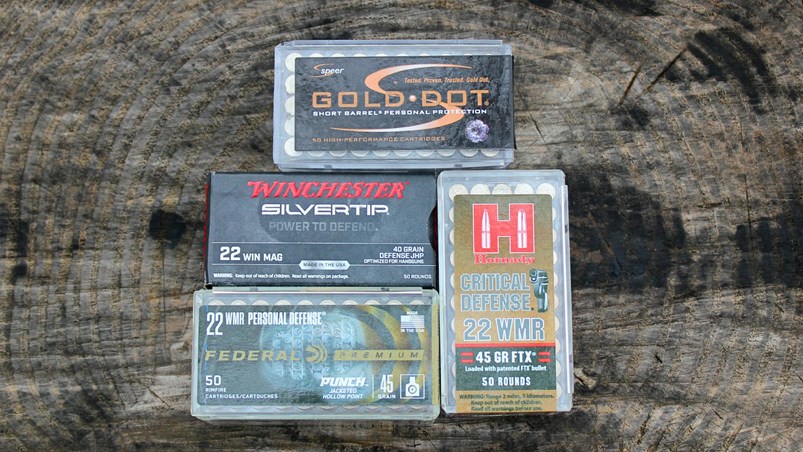
Defensive .22 Mag. loads use powders formulated specifically for shorter pistol and revolver barrels.
Until recently, the vast majority of available .22 Mag. ammunition has been designed with bullets and powder charges intended for use in sporting rifles. But these days folks can find defensive handgun specific loads from trusted American manufacturers including Federal, Hornady, Speer and Winchester. This discussion will focus on the three polymer-framed pistols currently in production, their features and what can be expected of them in regard to reliability, accuracy and performance.
A New Class of Low-Recoil Defensive Pistols?
The manufacturers of these three polymer-framed .22 Mag. pistols generally list them as sporting models intended for use as trail guns, small game hunting and the like. And yet, it's interesting to note that they all share several features common to full-size center-fire polymer pistols favored for home and self defense:
- They sport 4.3" to 4.5" barrels and have full length grips.
- The magazine capacities allow for 15+1 rounds of ammunition or more.
- They ship with fiber optic sights for improved visibility.
- The slides are micro red-dot optics ready.
- The dust covers have integral accessory rails for lights and lasers.
- The triggers are smooth and relatively light.
But these pistols are by no means clones of each other. In fact, each model employs a unique action design to manage the eccentricities of the .22 Mag. cartridge, including its varying pressure levels and tapered cartridge case. Here's more information about each model.
KelTec PMR30
The KelTec PMR30 is a single-action, hammer-fired semi-automatic which was released in 2010. It uses a hybrid blowback/locked-breech action with a sliding weight which is self-adjusting for changes in cartridge pressure. It is the lightest of the polymer .22 Mags. weighing in at just 15.4 oz. with an empty magazine inserted in the grip.
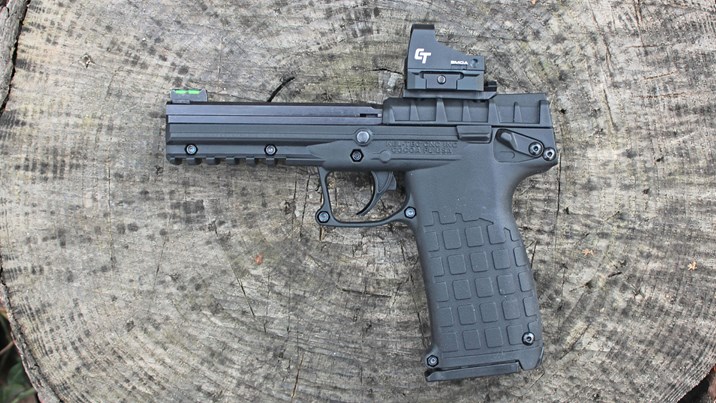
The KelTec PMR30 essentially established this pistol class back in 2010.
The PMR30's aluminum slide has a polymer cover secured by four screws. This slide configuration made the gun optics-ready from the get go. However, the company's optics mounting options are exceptionally limited and aftermarket options may be required to use the optic you prefer. For my latest review of this model, the gun was fitted with a polymer Tandemkross [TK] Freedom Picatinny rail mount (TK08N0029BLK1, $23.99) to support a light weight Crimson Trace model CTS-1550 with a 3-MOA red dot.
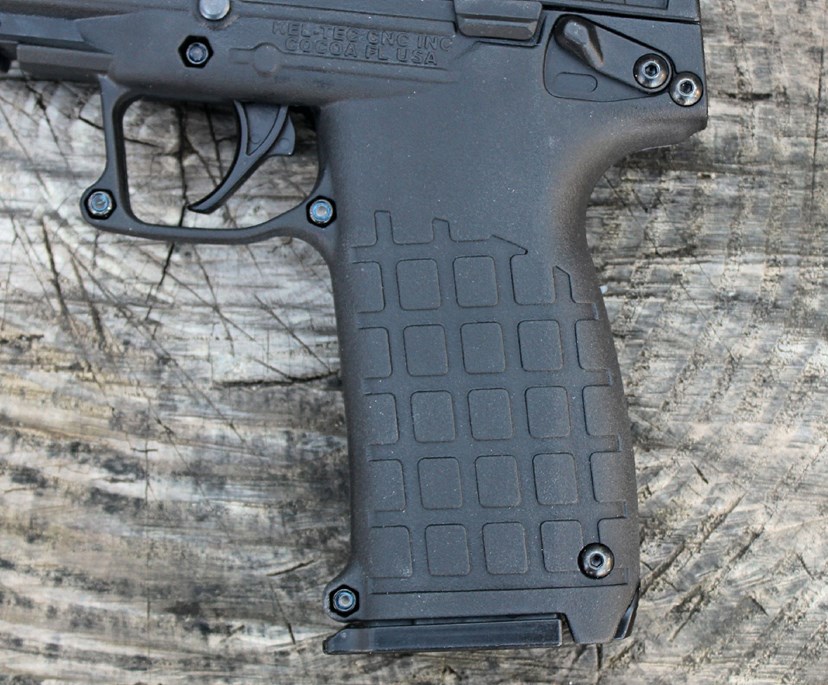
The PMR30’s magazine release is located in the heel of the grip just like older European combat pistols.
This model features a traditional external thumb safety and a single-action trigger pull of 3 lbs. 2 oz. The grip frame has an unusual pie-wedge shape which is relatively long, front-to-back, but remains slim side-to-side. The most innovative feature of the gun is the polymer double-stack, flush-fit magazine which holds up to 30 rounds of ammunition. The magazine release is located on the heel of the grip, instead of behind the trigger guard, to simplify the gun's design and to make it ambidextrous. The PMR30 is the least expensive option with a suggested retail price of $495.
Walther WMP
Manufactured in Germany, the WMP, or Walther Magnum Pistol, is a direct-blowback operated semi-automatic with a fixed barrel that arrived on the market in 2022. Although the trigger is fitted with an integral blade safety, like many striker-fired guns, this model has a double-action trigger connected to a recessed hammer. This hammer is partially cocked by cycling the slide and then fully cocked and fired by pulling the trigger.
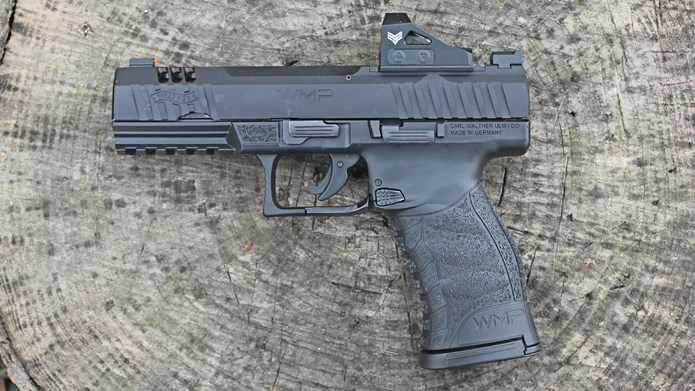
The Walther WMP takes its design cues from this company’s duty-size center-fire pistols.
The WMP looks and feels like a typical centerfire pistol while the other two have more slender profiles. The features, including the slide shape, control configuration and the hand-filling textured grip, are similar to those found on the PPX and Creed pistols. The WMP's aluminum slide gives this gun an unloaded weight of 27.1-oz. making it the heaviest of the trio. However, the weight contributes to it being the softest shooting of the bunch. The trigger stroke is similar to other Walther polymer pistols but it is lighter with a trigger pull of just 3-lbs 13-oz.
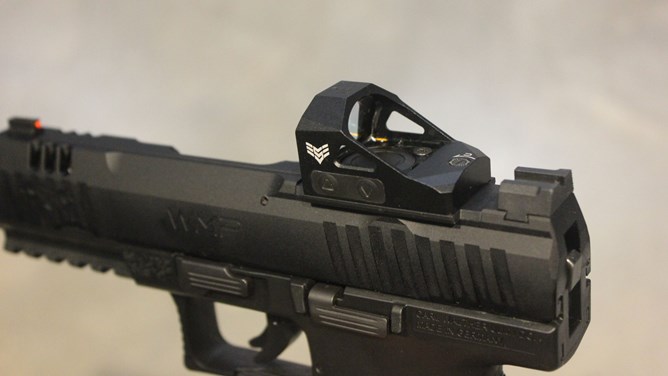
The Walther’s standard side slide allows for the use of larger RMR red-dot optics.
The ambidextrous magazine release button is located behind the trigger guard. The steel-lined polymer magazines hold up to 15 rounds with textured grip plates attached to the follower to aid in easy reloading. Keeping the Walther full-size pistol slide outline allows the WMP to be fitted with larger RMR-footprint optics as well as the smaller Shield RMSc sizes. Three red dot optics mounting plates are included which are sized for Trijicon, Docter, Vortex and Shield options. The pistol is shown here topped off with an RMR-size, 1x27mm competition-style Swampfox Justice optic with a 3 MOA red dot. This gun has a listed price of $549.
Smith & Wesson
The new-for-2023 Smith & Wesson M&P 22 Magnum was not originally designed to fire .22 Mag. cartridges. Instead, it's based on the company's M&P 5.7 which is chambered in 5.7x28mm. That being said, the .22 Mag. model employs the same innovative TEMPO 2-piece barrel system. It is a different, but effective, approach to making the action self-adjusting for changes in .22 Mag. bullet weights and pressure levels.
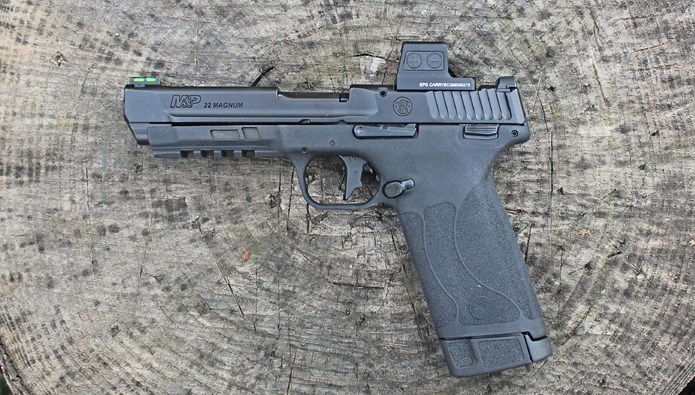
The Smith & Wesson M&P 22 Magnum pistol is based on the company’s 5.7x28mm semi-automatic.
This model follows the 5.7x28mm slide and grip frame design. Much like the PMR30, the slide and grip are narrower while the grip is a bit longer front-to-back. But it keeps the tough, one-piece, all-steel slide of the 5.7x28mm version. It's the middle-weight option with an unloaded weight of 22-oz. This pistol features two external safeties including a low-profile ambidextrous thumb safety lever and an integral trigger safety lever. The left-side magazine release button, which is found behind the trigger, can be reversed for left-handed operation.
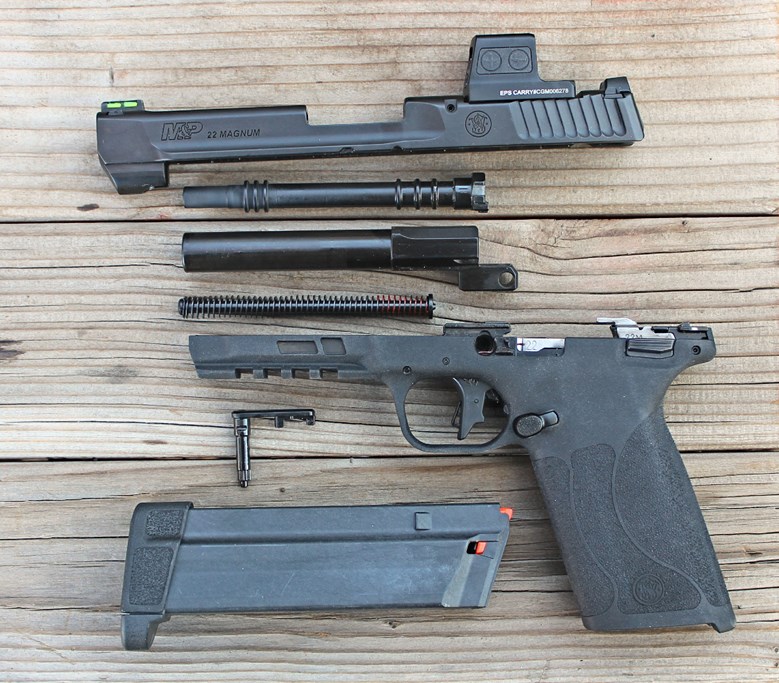
This pistol employs the TEMPO 2-piece barrel system.
Smith & Wesson developed a 30-round magazine to compete with the PMR30. It does protrude 0.75" past the bottom of the grip frame but the magazine base is textured to form a grip extension. The narrower slide profile restricts red dot optic options to those with the smaller Shield RMSc footprint. The gun is shown here with a Holosun EPS Carry MRS optic installed. The M&P has a suggested retail price of $649. A full review of this gun is available here.
.22 Mag. Pistol Handling
These pistols are just plain fun to shoot! While enjoyment is not the top priority when selecting a handgun, it certainly does contribute to the likelihood of more regular practice sessions. These pistols have slides which are easier to cycle manually than most center-fire pistols. Recoil is on par with many .22 LR pistols. However, the muzzle flash can be surprisingly bright with some loads and the report is louder than one might expect from such a slim cartridge. The magazines are generally easier to load, it just takes a bit longer to top off the models that hold 30 rounds.
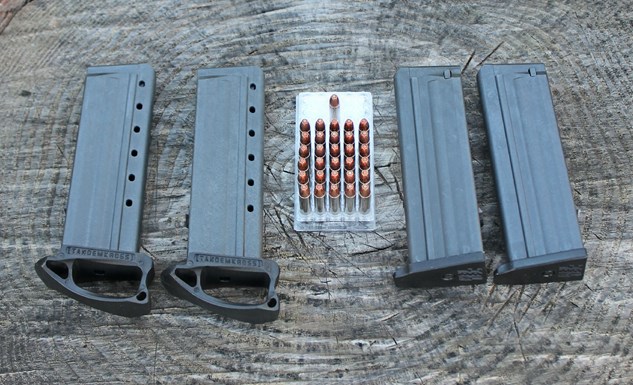
KelTec’s pie-wedge shaped magazines hold up to 30 rounds of ammunition for a total of 31 shots at the ready with one in the chamber.
.22 Mag. Ammunition: Options and Performance
I've conducted complete shooting range evaluations of all three of these pistols with formal 5-shot group, benchrested accuracy testing at 25 yards. In all three cases, the pistols were fired using red dot optics. In regard to defensive accuracy, I look for handgun, ammunition and optic combinations which consistently produce groups of around 3" to 3.5" in size at this distance. When using a red dot, I can shave up to around half an inch off of those group sizes when compared to using the iron sights. The Keltec PMR30 kept all groups between 2.11" to 2.87" in size, the Walther WMP's groups ranged from 2.13" to 3.38" depending on the ammunition used, and the Smith & Wesson M&P 22 Magnum's groups were between 1.56" to 2.53". In other words, they all met my defensive accuracy standards with room to spare.
The .22 Mag. has been around for quite some time so there is a fairly wide selection of ammunition to choose from. I've found that the pistol manufacturers recommended .22 Mag. cartridge lists and my own shooting experiences over the years boil down to this: .22 Mag. cartridges topped with jacketed bullets weighing 40- to 45-gr. are the most likely to feed, fire and eject properly when fired from handgun-length barrels. Nevertheless, any load that is going to be used for defense should be tested thoroughly with a given gun before using it in the field.
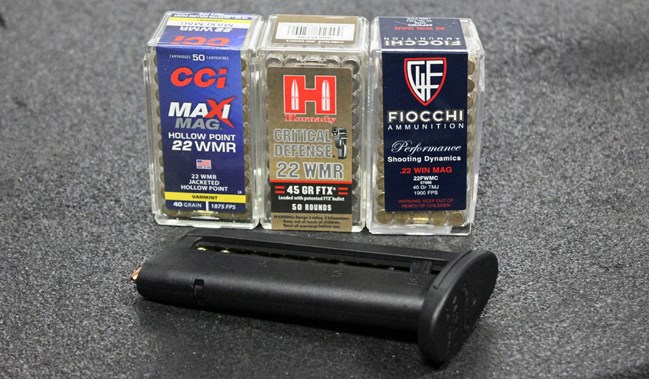
All three of these polymer pistols operate reliably with sporting and defensive .22 Mag. loads topped with jackted 40- to 45-gr. bullets.
When it comes to ammunition reliability, it is commonly and correctly stated that rimfire ammunition is more likely to experience primer failures than center-fire cartridges. This is why most folks don't even bat an eye at having half a dozen rounds from a brick of .22 LR practice-grade ammunition go “click” instead of “bang.” However, my experience has been that .22 Mag. ammunition is better made and noticeably more reliable than .22 LR. When wringing out a .22 LR handgun, I just plan on a few bad primers along the way, even with the premium loads. When testing the polymer-framed pistols discussed here, using the recommended premium loads, I didn't run into a single faulty primer in the hundreds of rounds fired from all three models. This level of ammunition reliability is a plus for .22 Mag. models when compared to .22 LR pistols.
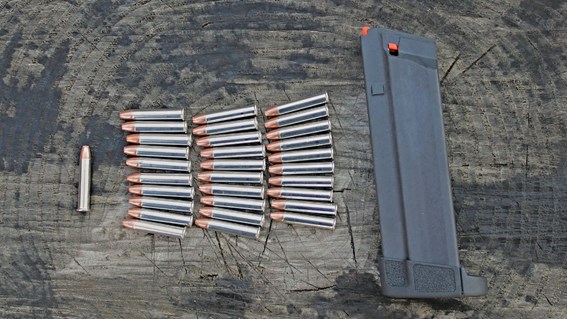
Smith & Wesson emulated KelTec’s 30-round capacity but with a different magazine design.
Next, let's talk about ammunition costs. As of this writing, .22 LR is around $0.08 per round for practice-grade loads or $0.12 to $0.15 a shot for high quality loads better suited to defense applications. So it's no surprise that .22 LR continues to be the low price king for reduced recoil. For 9 mm, which is now the standard centerfire caliber option for defensive handguns, you’re looking at around $0.45 per round for practice grade ammunition and between $1 to $1.50 per round for defense-grade hollow points. As for .22 Mag., reliable jacketed sporting rifle loads start at $0.30 with defensive handgun loads topping out at $0.45 to $0.50 per shot. In short, keeping a .22 Mag. pistol stoked with premium rounds costs about the same as loading up a 9 mm pistol with practice-grade fodder.
This brings us to performance, meaning, just how hard hitting is .22 Mag. (.22 WMR) fired from pistol-length barrels when compared to other calibers? The following table summarizes the muzzle energy levels generated by these guns alongside other handguns and a rifle I've tested:
Caliber Firearm Muzzle Energy Reference
.22 LR 4" Pistol 79 to 113 ft.-lbs. (Taurus TX22)
.22 LR 16" Carbine 105 to 147 ft.-lbs. (Winchester Wildcat)
.22 WMR 1.87" Revolver 113 to 126 ft.-lbs. (Ruger LCR Revolver)
.22 WMR 4.3" Pistol 140 to 178 ft.-lbs. (KelTec PMR30)
.22 WMR 4.35" Pistol 152 to 178 ft.-lbs. (Smith & Wesson M&P)
.22 WMR 4.5" Pistol 137 to 177 ft.-lbs. (Walther WMP)
.32 ACP 3.82" Pistol 136 to 179 ft.-lbs. (Beretta Cheetah)
.380 ACP 2.5" Pistol 184 to 240 ft.-lbs. (Ruger Security-380)
9 mm 3.2" Pistol 277 to 300 ft.-lbs. (Taurus G3C)
In essence, a .22 Mag. pistol's performance potential is comparable to that of a .22 LR rifle or a compact-size .32 ACP pistol. This makes it a more potent option than any .22 LR pistol. But as the table shows, even a pocket-sized .380 ACP is going to offer better performance with a sub-compact 9 mm generating roughly twice as much bullet energy.
Parting Shots
In summary, the polymer-framed .22 Mag pistols discussed here are, when loaded properly, more powerful, more reliable and likely to hold a good deal more ammunition in their magazines than typical .22 LR pistols. They also have popular defensive features including optics-ready slides, accessory rails, light weight construction and, in two cases, 30-round magazines. They are soft shooting with easy-to-rack slides. Price wise they are on par with popular 9 mm polymer pistols. They are more comfortable to operate than many center-fire semi-automatic pistols with easier to rack slides and magazines that don't require as much hand strength to load. The trade off is that the available models are all full-size handguns with relatively limited holster options for concealed carry.
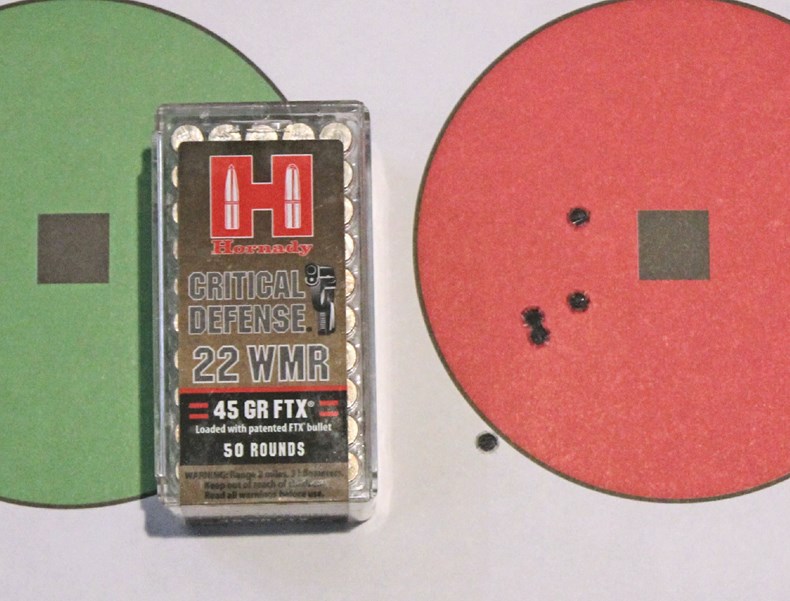
These pistols can keep groups comfortably under 3” in size and 25 yards.
Ammunition designed specifically for .22 Mag. pistols is still relatively limited but more diverse than ever before. The good news is if handgun loads are challenging to find in your area, commonly available sporting rifle rounds with jacketed 40-gr. or 45-gr. bullets will certainly get the job done. But pistols in this caliber are less than optimal choices for self defense when compared with compact and full-size pistols chambered in centerfire cartridges like .380 ACP and 9 mm. Nevertheless, if reduced recoil is a top priority for a defensive handgun, then the .22 Mag. polymer guns have a lot to offer.












